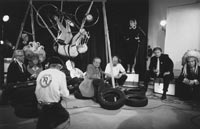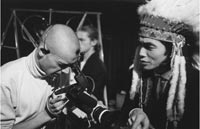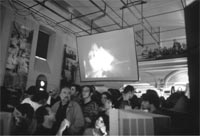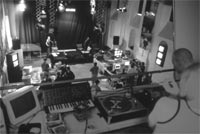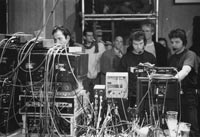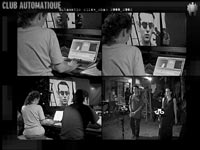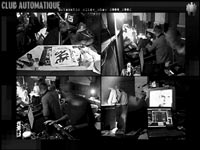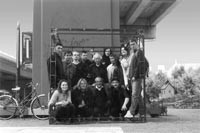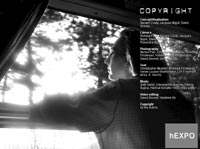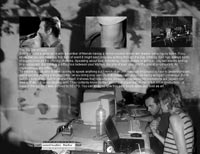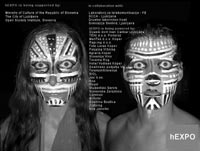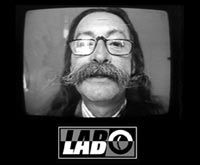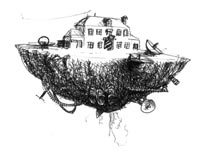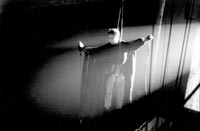David Dronet
Multimedia cultural centre Station Mir
Station Mir is a multimedia laboratory for research, creative and educational activities that are performed by a collective of artists that have emerged from the School of Fine Arts in Caen.
Since 1995 the Station Mir has developed numerous exhibitions as well as intervention and collective creative projects. On the basis of these practices Station Mir has simultaneously developed strong links with Normandy, national and international partners.
Today the association offers an irreplaceable posture, a unique intermediate position between the alternative space and the institutional structure. By offering support to artists, who are trying out new technologies and combining them with more traditional carriers, Station Mir is a referential actor at the start of new artistic practices.
Close co-operation with CloaQ, an association of artists working at the same location, expands the operational field of Station Mir while enabling it to host numerous projects within the frame of artistic residencies.
Anne Cartel
The Intermediacy of the Station Mir
Exchange, networks, mutual connections, understanding and intermedia are key words used to describe the activities carried out by the artistic collective Trance Femel Co. (an anagram of the French Telecom) ever since 1991. Station Mir was an initiative started by artists David Dronet and Stephan Zanini, who were both educated at the School of Fine Arts in Caen. They were not interested in a personal cult, but in the dialectics of communication, interactivity and their tools, that they have later on chosen as their artistic medium. Through a constant search and testing of new media interactive possibilities the collective Trance Femel Co. wished to provide easier access to the media also for other artists and thus encourage reciprocal exchange. In 1995 they established Station Mir (Multimedia-Interactive-Research). Even without the pun Station Mir is oriented towards the role of a satellite, a transmitter and receiver of multimedia research and production. This flexible, expandable space, which has become a part of the artistic chain that cannot be missed through its tendency to research, operates as a mediator between the existing spaces in the world of art.
Multimedia is the engine of the Station. There is no better notion for the interventions that are carried out by the Station Mir collective in the form of events. They participated on numerous occasions at the festival Les recontres Vidéo Arts Plastiques (VAP) in Hérouville-ST-Clair. Following the initial initiative for the event to be broadcast on the local television station, Station Mir and CloaQ (an artistic collective oriented towards spatial projects) proposed the project La Tour de Babel in 1999. This installation composed from mixed volumes that are linked by a four storey high metal construction orchestrates electronic music, video and VAP transmission via a cable and the Internet and thus symbolises the reproduction of the artistic approaches started at the festival. On the boarder of the tower there is a bar that encourages social life. This is linked to the idea of the project Mir de Bar, which has been in development by Station Mir ever since 1996. This is an installation that can be dismantled and reassembled in another, more organic In Cube project, which has travelled from Querqueville in Normandy to Quebec through the co-operation with Culture Commune in Loos-en Gohelle. The installation is made out of two times two metres large cubes that are linked with a metal structure. The combination, the way in how they are linked is always adjusted to the place of exhibiting. Every artist or collective places himself within one or more cubes. The fields of thought and production are crossed, sometimes they influence each other and sometimes they interact at a distance - I.
Station Mir creates and publishes audio CDs and CD-ROMs. Since 1998 two collections have been published. The first is Fractal Music, which includes sound and experimental (noise, sound poetry, etc.) compositions under the artistic leadership of Joël Hubaut. The other is No(w)here, which is produced in partnership with Culture Commune. This is a virtual simulation of the mine 11/19 in Loos-en-Gohelle, where the invited artist formulated his work especially for this mine and thus dragged the user into a virtual and realistic journey across the work of art - M.I.
Mir X-presse, a book of the artist, presented on the cover of the CD-ROM offers a different space, which is based on the limitations of the format. So far nine issues have been published with regional and other artists: Manuel Passard, Gilles Soilly, Eric Mareau, Xavier Lucas, Christophe Tarkos, Frédéric Lecomte, Christian Gratia and Yveline Lécuyer. Artists adjust this publication as the new carrier of their activities. IRM (Imagerie par Résonance magnetique), a magazine published quarterly offers a carte blanche to artists, writers, poets and critics who wish to set up their research in a different way and use the magazine to express themselves freely - M.R.
Events with their ephemerality are a part of life on Station Mir and they present a direct response to the transitoriness of the media and the games they play. In this continuous mixture of art and life the Station Mir collective exposes the interactive character of the media and constructs events, which use spectators as transmitters or receivers of their activities. In 1999 the Foundation Cartier invited them to co-operate within the frame of the cycle of events Soirées Nomades in Paris. Following the initiative of Joël Hubart they presented Fractal Pacsing Musik, a project, which uses as its base eight artists that started from the Fractal Music collection and supplements them with eight incompatible artists. This, of course, starts off collisions, multiplications and disturbances of viewpoints and 'hearing' points. The artists from the station like to use various events to co-create with the external world, i.e. the streets (Les Arts dans la rue in Chatillon, 1999; Cut Off, Close the Windows, a techno-video concert in l'Hotel de la Duchesse Anne in Nantes, 1999). They also like developing other forms of closeness with the audience, for instance through social evenings in Mir de Bar, where the multimedia installations, video and concerts intertwine with gatherings and debates over a glass of wine. On certain occasions such exchange includes art students. In 2001, the Club Automatique, a collective of intermedia artists (Michael Piet, Gérard County, etc.) which takes advantage of a form of culinary events, suggested that they should together with Station Mir hold a workshop for the students of the School of Fine Arts in Caen. This was to take place at the festival Vidéo Arts Plastiques. The installation was set up in the form of a culinary chain, the industrial and serial character of which is repeated in a return loop, with a true tasting offered to the audience. The transparency of the creation of dishes and the process itself reach the desired effect. With the support of the French Cultural Centre in Djakarta, AFAA (the French Association for the Promotion of Art) and the region of Lower Normandy this initiative was repeated one year later. This time the project (the basis of which was the combination of a multimedia installation and a culinary performance) encompassed a workshop with Indonesian students. One of the key words of the Station Mir members was exchange, in the national and well as international sense (Culture Commune - the national scene in Loos en Goelle, Le Lieu in Quebec, the Goethe Institute in Hamburg, LIP in Djakarta, La Friche Belle de Mai in Marseille, etc.). The desire to establish networks is realised in the television media: Univers City TV - an international television network of artists, artistic schools and associations, which enables a utopia of experimental television. This process is linked to creation and leads to projects such as UBIK in Quebec (1996), FMR TV (1996), VAP in Héroville-St-Clair. On the local level Station Mir has started the project Lav ©, which is planned to spread on Cable 9 in Héroville-St-Clair. The goal of this project is for it to be a small peephole into the world of creation, a new space for experimenting, an offered and not enforced reading of art - M.I.R.
R. The space of experimenting, Research and education. Through the artists in residence programme Station Mir is also intended for exchanges and guest artists. Since 1998 over 30 artists have lived, developed and created at the Station. This is a list of artists who have recently stayed here: Loic Connanski, Lydie Jean-dit-Pannel, Jean-Paul Labro, Unglee, Philippe Lepeut, Anne-James Chaton, Sammy Engramer, Jacques Donguy, etc. At Station Mir a response can be found for videos as well as films, musical poetry and conceptual writings. As regards their needs the guest artists have at their disposal a number of studios and the knowledge of the permanent members: a sound studio, a graphic design studio, as well as studios for 3D, video and homepage design.
The permanent Station Mir artists also use these tools for their artistic practice. On the basis of the work Apocalypse by Serge Feray David Dronet made the video Mirages from which he drags out images, re-works them and exhibits them as a series of photographic compositions. At this he plays with the boarder between art and graphic design as well as with the thin line between technology and bad luck or human disaster. Starting from the performance si04, which he performed in 2001 as a student of the School of Fine Arts in Caen Eric Mareau created a video. Sophie Aumont, Virginie Osmont and Sylvain Tranquart, better known under the name Collectif Occasionnel are the initiators of the brief actions and interventions. These actions are either spontaneous or premeditated performances that take place in various environments, and are later on marked by video works or installations. Christophe Bouder and Manuel Passard, who both emerged form the collectives Station Mir and CloaQ are developing the project Les Colonnes in the sense of actualisation. This is a work, which in a hybrid way joins computer engineering placed onto monitors, which are in turn placed on metal columns and the simulation of the real environment into which these columns are placed. The content of the monitors offers the user a virtual visit of a true environment in which the sculptures are set. Of course we mentioned only some of the typical cases of the real creative friction, due to which Station Mir is an intermediate space that cannot be missed by any intermedia artist.
Station Mir uses these tools as a response to the needs of institutions, such as the Centre for Contemporary Art of the Lower Normandy (art library ), FRAC of Lower Normandy (graphic design of communication documents, video edits, etc.). In this way the association is to a great extent self-financed, however, it does receive subsidies from ODACC , DRAC and the town of Hérouville-St-Clair, which gives them rent-free use of spaces.
